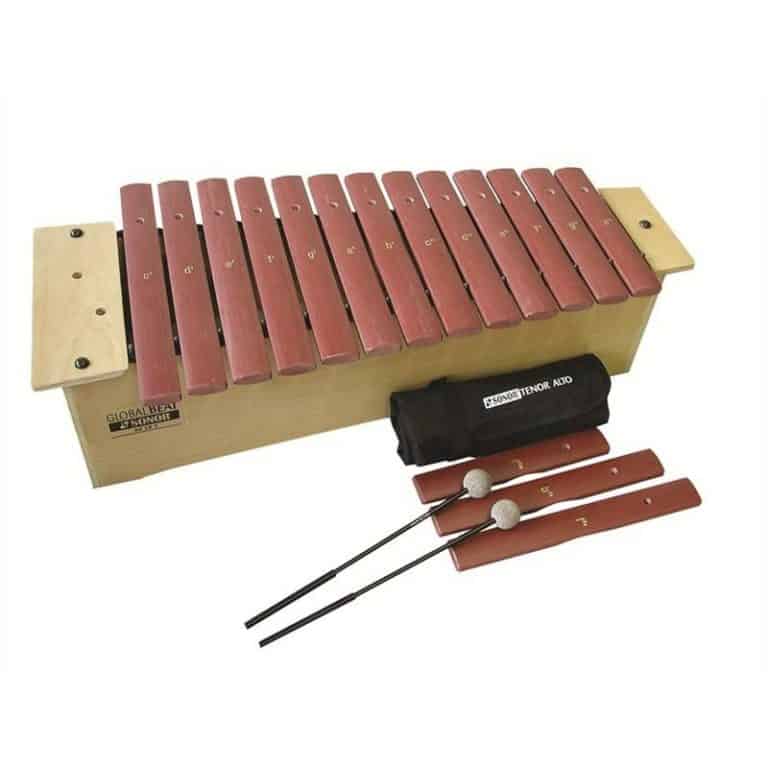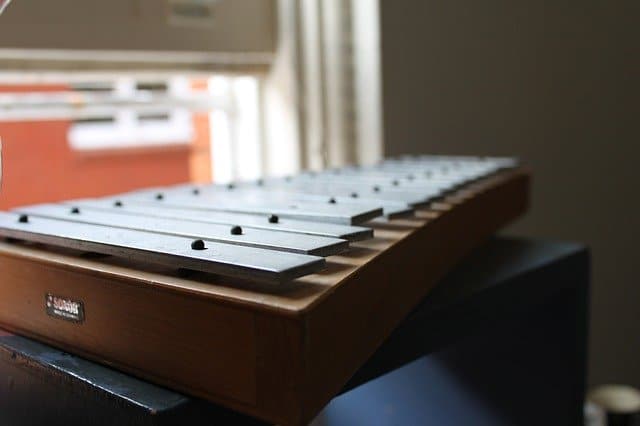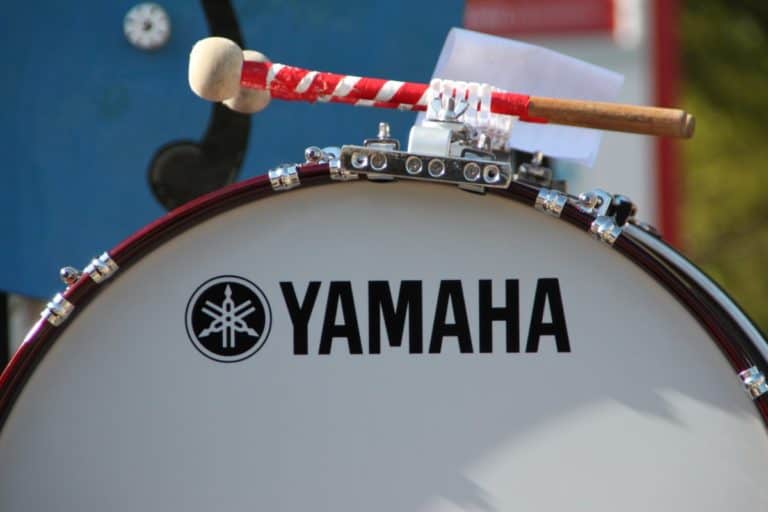Xylophone History and its Place in the Orchestra
A question often asked is whether the xylophone features in the orchestra. This article answers that question, explains who plays it and how long it has been included.
Is the Xylophone in the orchestra? – The xylophone has formed part of the percussion section of the orchestra since 1874, with the first composition specifically for the instrument coming in 1893. A percussionist will play the xylophone in the orchestra as opposed to a xylophonist, as the percussionist will play several instruments as required.
The xylophone is an established player in the orchestra’s percussion section. It has a unique musical voice which makes it a valued orchestra member. Read on for just about as much as you would want to know about xylophones.
The Xylophone in The Percussion Family
Percussion means “the hitting of one body against another.” Hence, percussion instruments are those played by being struck, scraped, or shaken. A variety of rhythms, textures, and tone color are provided by the percussion instruments in an orchestra.
Percussion instruments go under two classifications, the tuned instruments, and the untuned ones. Specific pitches or notes are played by tuned instruments. These instruments include the stringed instruments, brass, woodwind, and the xylophone. Untuned instruments have an indefinite pitch with the sound that they produce. It is just like the sound of someone knocking on a door.
The percussion family makes up a huge part of the entire orchestra. In order to be a good percussionist, you need to practice a lot so that you can hit the instrument with the right amount of strength, in the right place, and at the right time.
What is a xylophone?
The term xylophone comes from two Greek words, xylone which means “wood” and phone, which means sound.’ So, xylophone means wood sound.
The xylophone is a musical instrument made of hardwood bars in graduated lengths which are set horizontally on a metal frame. On the left side of the instrument are the larger, lower sounding bars. It pretty much looks like a piano keyboard the way the xylophone notes are laid out. To produce a sound, the bars have to be struck with a hard mallet. The sound produced by the struck instrument is a bright, sharp sound.
There are twenty-seven (or more) hardwood bars which are graduated in lengths that are mounted on taut cords. These are all set in a suitable framework. The arrangements of the wooden bars are in two rows similar to piano keys. These wooden bars are also tuned accurately. The instrument is played by striking the bars with beaters or mallets made of boxwood or willow.
By using different kinds of mallets, the quality of the pitch can be changed. The mallets can either be soft or hard. You can also hit the wooden bars in many different ways. Metal tubes called resonators are also attached at the bottom of the wooden bars. The resonators make the sound vibrate. This is the reason for the bright bell-like sound that the xylophone makes.
History of the Xylophone in the Orchestra
It was in Asia and Africa that the first xylophone was made and used. It was as early as 2000 BC when xylophones were used in ancient Southeast Asia. These instruments were brought by the Malay-Polynesians to Africa.
In the 14th century, xylophones were first mentioned in what is now Mali, on the Niger.
In the 16th century, sophisticated xylophones were reported by Portuguese missionaries in Ethiopia. These xylophones had resonators made of calabash and a type of kazoo (mirliton) producing buzzing noises that resonate.
In 1511, xylophones were called wooden clatter’ and soon it was also called straw fiddle’ in Europe. The reason for this name is that the bars were supported on straw. In this folk instrument, the bars extended away from the player instead of in a line across him.
Arrival in Europe
People think that the xylophone arrived in Europe during the Crusades. Arnold Schlick, a German organist, called the xylophone “hultze glechter” or wooden laughter. This was how the German-speaking regions called the instrument. Soon enough, many influential theoreticians of the age, mentions the xylophone, including Martin Agricola and Michael Praetorius in his Theatrum instrumentorum.
In the Middle Ages, there were no resonators used for xylophones, which were very simple instruments. And these instruments were used mostly in circuses and by wandering minstrels. This was the situation until the 19th century.
In 1523, Hans Holbein the Younger included the xylophone in his famous painting Dance of Death. Here he portrays the xylophone with the image of death. A skeleton plays a portable xylophone in a procession. Sound from the xylophone symbolizes the rattling of bones. This is the first known portrayal of a xylophone in Europe.
Xylophone enters the orchestra
It was only during the 19th century that the xylophone was discovered as an instrument for the orchestra. In 1893, the first composition for the xylophone was presented by Ignaz Schweigi. And another composition was written by Ferdinand Kauser (Sei Variazioni) also for the xylophone, in 1810.
In 1830, a Russian Jewish xylophone virtuoso by the name of Michal Josef Gusikov toured Europe. He played on a wood-and-straw instrument. This created a sensation in Paris and Vienna. With this popularity, the xylophone became a fashionable solo and garden concert instrument.
The term xylophone was formally used in reference to the instrument in the 1860s. In the British literary magazine, Athenaeum, the first known attestation of the name xylophone was given. Here it is written, “A prodigy… who does wonderful things with little drumsticks on a machine of wooden keys, called the xylophone.”
The first major orchestral appearance of the xylophone was in 1874 when Camille Saint-Saens’ wrote a musical depiction of the Dance of Death called La Danse Macabre. Later in 1866, Saint-Saens also wrote Le Carnaval des Animaux where the xylophone was also used.
In the same year, Albert Roth published a tutorial for the xylophone but for the four rowed instruments. In this tutorial, Roth also introduced a two-row chromatic arrangement that followed the piano keys’ pattern. This was the start of the development of the modern orchestra xylophone.
Another opera where a xylophone was used was the Hansel and Gretel production of Humperdinck (Arnold George Dorsay), a German composer, in the year 1893.
The Xylophone on Broadway
In the late 19th century, the xylophone became popular as a part of Harrigan and Hart’s comedy routines. The success of this duo in Broadway helped the xylophone to become a mainstay in American musicals today.
The 20th century saw the xylophone becoming important to classical music as well as to musicals. John Calhoun Deagan was one of the first major manufacturers of the modern orchestra xylophone in 1903. These xylophones soon became the standard instrument in a symphony orchestra, theater, and dance bands.
The popularity of the xylophone at this time was also partly due to the good sound that it had on early records. Composers of the 20th century also gave parts to the xylophone that became larger and more important. Some of the composers who placed percussion instruments at the forefront of musical performance included Igor Stravinsky, Bela Bartok, Olivier Messiaen, Edgard Varese, Pierre Boulez, and Karlheinz Stockhausen.
The xylophone also became popular from 1910 to 1940 as part of vaudeville acts. Xylophones were also used by jazz musicians in their bands until it was replaced by the vibraphone in the 1940s.
In the 1970s, the music of percussionist Bob Becker and his ensemble NEXUS featured the xylophone in ragtime. Other notable works that used the Western xylophone prominently include The Golden Age (1930) by Dmitry Shostakovich, Le Marteau sand Maitre (1954; The Hammer Without a Master) by Pierre Boulez, and the solo piece Fantasy on Japanese Wood Prints (1965) by Alan Hovhaness.
The First Xylophones
The piano-like appearance of the xylophone was not established until the 20th century. In the 16th century Europe, xylophone bars were laid out on straw in four rows instead of two. This was the instrument used for over 300 years.
In East Africa, they had what was called a loose bar xylophone’ which was placed over banana stems. This might have become the inspiration for the straw xylophone.
In Africa, you will find many forms of xylophones. One is the amadinda which is made of logs. Each key is provided a gourd resonator. Sometimes a mirliton is set in the resonator well. This gives the tone a buzzing edge. These instruments were also called balo or balafon.
Also commonly used were xylophones with no resonators. They have what is called a free-key xylophone which has its keys placed over two logs or a pit.
The standard for xylophones is that the keys increase in pitch from left to right. However, some xylophone models in Africa have keys that increase in pitch outward from the center. This is to accommodate the natural movement of the arms. Other instruments place octaves next to each other and the lowest pitches to the right. It is quite impressive how African xylophones show variety and musicality.
While African xylophones are called balafon, xylophones in Mozambique are referred to as Mbilia. In Burkina Faso, Ghana, Mali, and West Africa, they call the xylophone gyil. And in western Zambia, the xylophone is called silimba.
How the Xylophone is Made
The material used for the bars of a xylophone is rosewood or Kelon which is a type of fiberglass. A true xylophone must have rosewood keys. There are xylophones that have a small range of 2 octaves. Concert xylophones, however, have 3 to 4 octaves. The xylophone is a transposing instrument with its parts written one octave below its sounding notes.
The material for the xylophone resonators is aluminum. This aluminum tubing is bought in bulk from a specialty metal fabricator. The keys are supported at the nodal points with cords or pads of felt, wool, synthetic, rubber, or other materials. These support rest on the frame over the resonators.
Wood or metal is used to construct the frame. The finished appearance of the instrument is decided upon by the customer or the manufacturer. Fine wood is used for the frames of instruments used by professional percussionists. They are finished by craftsmen who are skilled in the trade. Xylophone frames, however, are very simple without any ornaments, unlike other wooden instruments. To finish the wood, the craftsman uses stains and varnish.
Xylophone Keys in detail – (Material, Length, Tuning)
Xylophone keys have different lengths that produce different sounds. The shorter bars produce high notes while the longer bars produce low notes. At the support ends of the keys, holes are drilled where they will be fitted to the nodes. To provide accurate pitch, the craftsman has to carve a gentle arch on the underside of the key.
When the tuning is finally done, the bar is gently sanded. When all the bars are tuned, they are polished, stained, and varnished. The customer and the manufacturer then choose the color of the stain to be used on the bars.
A string or cord ties the bars of a xylophone together. This holds them in place so that when struck with a mallet, they will be able to vibrate to produce sound. To amplify the sound, a resonator tube is placed under each bar of the xylophone.
There are 42 to 48 wooden bars on xylophones used in concert halls. Different sounds are produced by different types of wood used to create the bars of a xylophone. Hardwood is the most common wood used but sometimes bamboo is also used.
The Xylophone Mallet
There are a variety of materials used to make the xylophone’s mallet. This includes wood, metal, or rubber. For softer effects, medium to hard rubber mallets with very hardcore or yarn mallets are used. If you want to create lighter tones on the xylophone, wooden-headed mallets made from rosewood, ebony, birch, or other hardwoods may be used.
There are 2 parts to a mallet – the stick ad the head. The materials used for the stick can be bamboo, birch, rattan, or fiberglass. Hard rubber or plastic is used for the spherical heads. These have an internal core of cord that is wound. This is similar to the inside of a golf ball.
Mallet heads can also be made of tightly wrapped wool. There are three varieties of mallets used by xylophone players. These mallets are constructed with different combinations of sticks and heads. This helps produce a wider variety of sounds. Xylophone players chose their mallets according to the music they are playing, the sound of the instrument, and the strength and technique of their wrists.
Characteristics of Xylophone Sounds
Xylophone sounds can be described in many different ways. It can be hard, bright, incisive, wooden, rattling, sharp, precise, penetrating, brittle, accentuated, drop-like, piercing, transparent, clear, shrill, hollow, and ticking.
The impression of precision it creates and the lack of resonance distinguishes the sound of the xylophone.
Another characteristic of the xylophone sound is that it is difficult to hear the octave positions correctly. This is especially true for the highest registers. The reason for this is the greater proportion of higher partials. This is why it becomes necessary to transpose individual xylophone parts down an octave so that the requirements of the room are met.
The diameter and hardness of the mallet head determine the sound created by the xylophone. the harder the mallet, the higher the number of partials that sound. The timber is also brighter, harder, and shriller. If the mallet is soft, then the higher partials are damped. The timber becomes darker, softer, and rounder.
How to Play the Xylophone
The skill of the xylophone player determines the sound produced from the xylophone. When the player stands to play the instrument, he faces its center. He must stand erect, hold the mallet between the thumb and the first joint of the first finger. He holds one mallet per hand.
To move the mallets smoothly up and down, one must use the wrists with the palms facing out. the arms should not move and it should be held down near the keyboard. The lower register of the xylophone is played by the player by taking one step to the left. When the upper register is played, the player takes one step to the right. The player has to always return to the center.
When notes are struck, they need to be struck in the center of the bars. When playing sharps or flats, the edges of the bars are struck but not the parts that rest directly on the frame. The widest part of the xylophone is on the lowest end. The narrow ends make the highest notes.
Critical to playing the xylophone is mallet grip. It is important to stay relaxed and completely controlled. When both hands hold the mallets the same way, it is called the matched grip. The pivot point is the point where each mallet is held between the thumb and the first joint of the first finger. The pivot point allows the mallet to rebound naturally. The combined movement of the finger, wrist, and forearm provides the force to strike the bars.
Xylophone Related Questions
What is the frequency range of a xylophone?
The frequency range of a xylophone is from 261 Hz to 4.2 kHz.
What do you call someone who plays the xylophone?
A xylophone player Is called a xylophonist.
Why is the xylophone frequently featured in alphabet books for children?
The xylophone is frequently featured in alphabet books for children because it is one of the few words that begin with the letter x that a child would know.
When was the xylophone’s piano-esque appearance established?
This appearance wasn’t established until the 20th century. In the 16th century, xylophone bars were laid out on straw in four rows instead of two. This practice continued for over 300 years.
What are some other uses of the xylophone?
In Senegal, xylophones were used as part of initiation ceremonies. They were played by young boys and girls. Other uses of the xylophone include scaring birds, monkeys, and pests out of the gardens. It is also used to effect the sound of clanking bones. Good for Halloween movies.






![Best Percussion Instruments For Kids [That you can play too]](https://cdn-0.coolpercussion.com/wp-content/uploads/2020/09/woman-4010110_1920-768x512.jpg)
